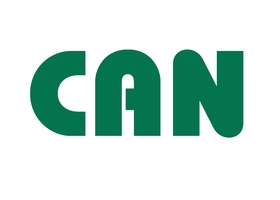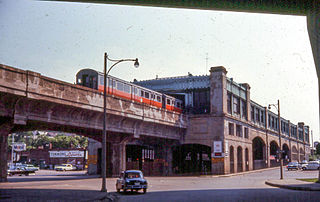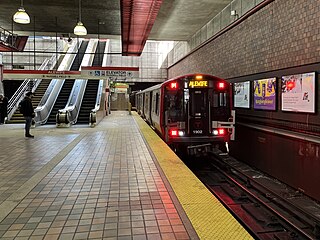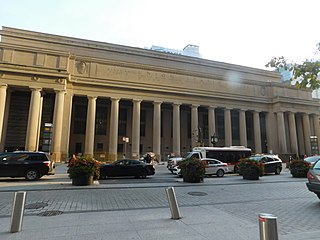
Commuter rail or suburban rail is a passenger rail transport service that primarily operates within a metropolitan area, connecting commuters to a central city from adjacent suburbs or commuter towns. Commuter rail systems are considered heavy rail, using electric or diesel trains. Distance charges or zone pricing may be used.

Network topology is the arrangement of the elements of a communication network. Network topology can be used to define or describe the arrangement of various types of telecommunication networks, including command and control radio networks, industrial fieldbusses and computer networks.

Light rail transit (LRT) is a form of passenger urban rail transit characterized by a combination of tram and rapid transit features. While its rolling stock is similar to that of a traditional tram, it operates at a higher capacity and speed and often on an exclusive right-of-way. In many cities, light rail transit systems more closely resemble, and are therefore indistinguishable from, traditional underground or at-grade subways and heavy-rail metros.

A controller area network (CAN) is a vehicle bus standard designed to enable efficient communication primarily between electronic control units (ECUs). Originally developed to reduce the complexity and cost of electrical wiring in automobiles through multiplexing, the CAN bus protocol has since been adopted in various other contexts. This broadcast-based, message-oriented protocol ensures data integrity and prioritization through a process called arbitration, allowing the highest priority device to continue transmitting if multiple devices attempt to send data simultaneously, while others back off. Its reliability is enhanced by differential signaling, which mitigates electrical noise. Common versions of the CAN protocol include CAN 2.0, CAN FD, and CAN XL which vary in their data rate capabilities and maximum data payload sizes.

The spoke–hub distribution paradigm is a form of transport topology optimization in which traffic planners organize routes as a series of "spokes" that connect outlying points to a central "hub". Simple forms of this distribution/connection model contrast with point-to-point transit systems, in which each point has a direct route to every other point, and which modeled the principal method of transporting passengers and freight until the 1970s. Delta Air Lines pioneered the spoke–hub distribution model in 1955, and the concept revolutionized the transportation logistics industry after Federal Express demonstrated its value in the early 1970s. In the late 1970s the telecommunications and information technology sector subsequently adopted this distribution topology, dubbing it the star network network topology.

A third rail, also known as a live rail, electric rail or conductor rail, is a method of providing electric power to a railway locomotive or train, through a semi-continuous rigid conductor placed alongside or between the rails of a railway track. It is used typically in a mass transit or rapid transit system, which has alignments in its own corridors, fully or almost fully segregated from the outside environment. Third-rail systems are usually supplied from direct current electricity.
Hybrid fiber-coaxial (HFC) is a broadband telecommunications network that combines optical fiber and coaxial cable. It has been commonly employed globally by cable television operators since the early 1990s.

The Boston Elevated Railway (BERy) was a streetcar and rapid transit railroad operated on, above, and below, the streets of Boston, Massachusetts and surrounding communities. Founded in 1894, it eventually acquired the West End Street Railway via lease and merger to become the city's primary mass transit provider. Its modern successor is the state-run Massachusetts Bay Transportation Authority (MBTA), which continues to operate in part on infrastructure developed by BERy and its predecessors.
The Urban Ring was a proposed project of the Massachusetts Bay Transportation Authority and the Massachusetts Department of Transportation, to develop new public transportation routes that would provide improved circumferential connections among many existing transit lines that project radially from downtown Boston. The Urban Ring Corridor is located roughly one to two miles from downtown Boston, passing through the Massachusetts cities of Boston, Chelsea, Everett, Medford, Somerville, Cambridge, and Brookline. The project was expected to convert 41,500 car trips to transit trips daily.

The Washington Street Elevated was an elevated segment of Boston's Massachusetts Bay Transportation Authority subway system, comprising the southern stretch of the Orange Line. It ran from Chinatown through the South End and Roxbury, ending in Forest Hills in Jamaica Plain, Boston.
In a hierarchical telecommunications network, the backhaul portion of the network comprises the intermediate links between the core network, or backbone network, and the small subnetworks at the edge of the network.

Delhi has significant reliance on its transport infrastructure. The city has developed a highly efficient public transport system with the introduction of the Delhi Metro, which is undergoing a rapid modernization and expansion since 2006. There are 16.6 million registered vehicles in the city as of 30 June 2014, which is the highest in the world among all cities, most of which do not follow any pollution emission norm, while the Delhi metropolitan region has 11.2 million vehicles. Delhi and NCR lose nearly 42 crore man-hours every month while commuting between home and office through public transport, due to the traffic congestion. Therefore, serious efforts, including a number of transport infrastructure projects, are under way to encourage usage of public transport in the city.

A transport hub is a place where passengers and cargo are exchanged between vehicles and/or between transport modes. Public transport hubs include railway stations, rapid transit stations, bus stops, tram stops, airports and ferry slips. Freight hubs include classification yards, airports, seaports and truck terminals, or combinations of these. For private transport by car, the parking lot functions as a unimodal hub.
Transport in Greater Kuala Lumpur includes a road network, a railway network, airports, and other modes of public transport. Greater Kuala Lumpur is conterminous with the Klang Valley, an urban conglomeration consisting of the city of Kuala Lumpur, as well as surrounding towns and cities in the state of Selangor. The Klang Valley has the country's largest airport, the Kuala Lumpur International Airport (KLIA), as well as the country's largest intermodal transport hub and railway station, Kuala Lumpur Sentral.

Rail transport plays a crucial role in connecting various regions of Thailand, transporting both goods and passengers through a range of transportation options that include inter-city and commuter rail, mass rapid transit, monorails, and airport rail links. The State Railway of Thailand (SRT) operates a network of intercity railways spanning 4,845.1 kilometers, covering 47 provinces across the country. SRT is committed to developing railway lands through its subsidiary, SRT Asset (SRTA), which focuses on transit-oriented development (TOD) initiatives. The Krung Thep Aphiwat Central Terminal in Bangkok serves as the primary transportation hub for rail transport in Thailand, connecting various types of rail transportation throughout the country. It covers an area of 274,192 square meters, making it the largest railway station in Southeast Asia, and is situated in a new central business district (CBD) that is currently being developed.

The Massachusetts Bay Transportation Authority (MBTA) operates rapid transit, light rail, and bus rapid transit services in the Boston metropolitan area, collectively referred to as the rapid transit, subway, or the T system.

Rapid transit or mass rapid transit (MRT), also known as metro, is a type of high-capacity public transport that is generally built in urban areas. A rapid transit system that primarily or traditionally runs below the surface may be called a subway, tube, or underground. Unlike buses or trams, rapid transit systems are railways, usually electric, that operate on an exclusive right-of-way, which cannot be accessed by pedestrians or other vehicles. They are often grade-separated in tunnels or on elevated railways.
A relay network is a broad class of network topology commonly used in wireless networks, where the source and destination are interconnected by means of some nodes. In such a network the source and destination cannot communicate to each other directly because the distance between the source and destination is greater than the transmission range of both of them, hence the need for intermediate node(s) to relay.

The Southeastern Pennsylvania Transportation Authority (SEPTA) operates a 25 Hz traction power system in the vicinity of Philadelphia, that it inherited from the Reading Company. This system is separate from, but similar to, the system built by the Pennsylvania Railroad (PRR), which is now operated by Amtrak. SEPTA's trains can run over either system because the voltage and frequency presented to the locomotive are essentially identical. However, the ex-Reading system is not electrically connected to the ex-PRR system.

Public transportation in the Canadian city of Toronto dates back to 1849 with the creation of a horse-drawn stagecoach company. Today, Toronto's mass transit is primarily made up of a system of subways, buses, and streetcars, covering approximately 1,200 km (750 mi) of routes operated by the Toronto Transit Commission (TTC) and inter-regional commuter rail and bus service provided by GO Transit.















